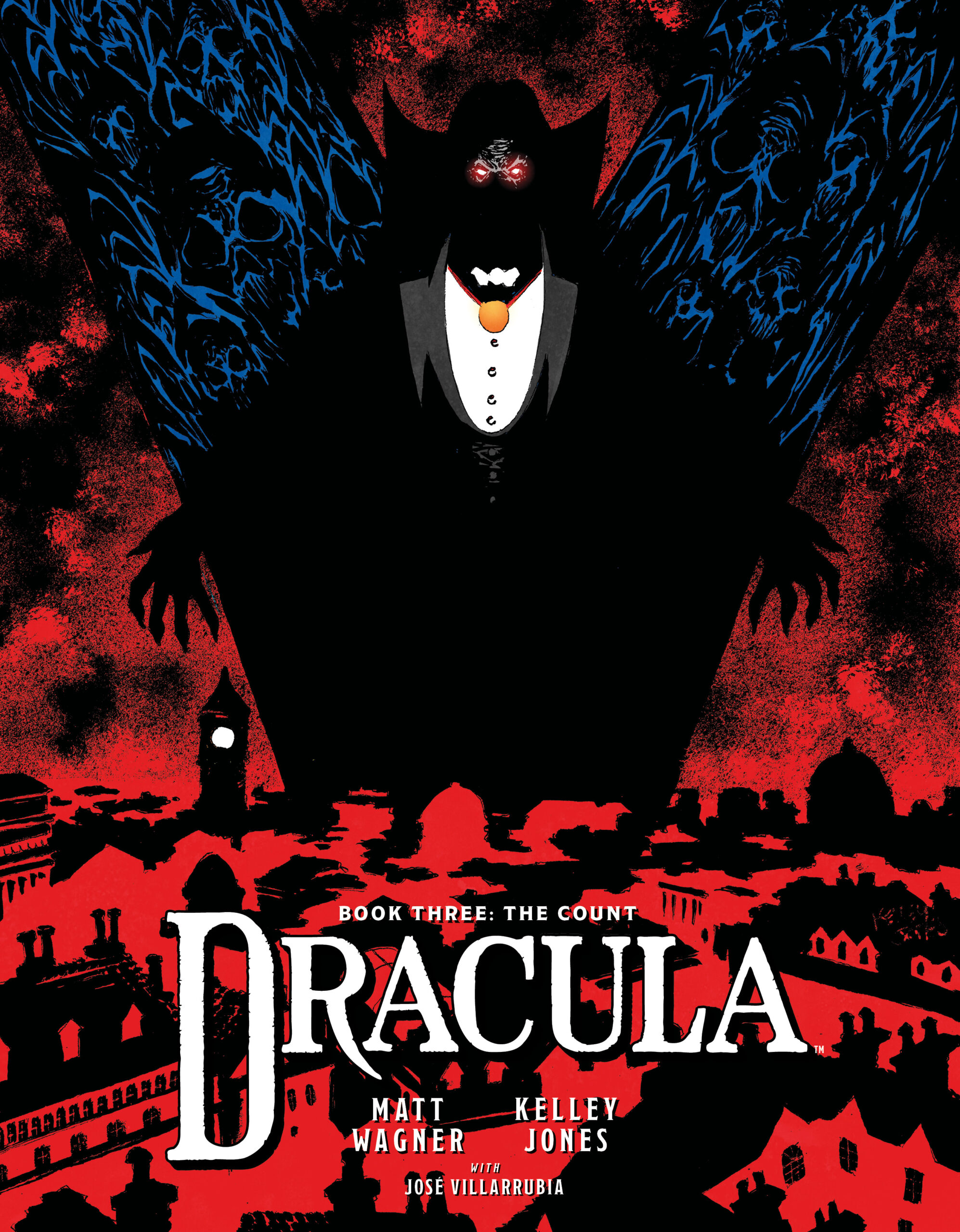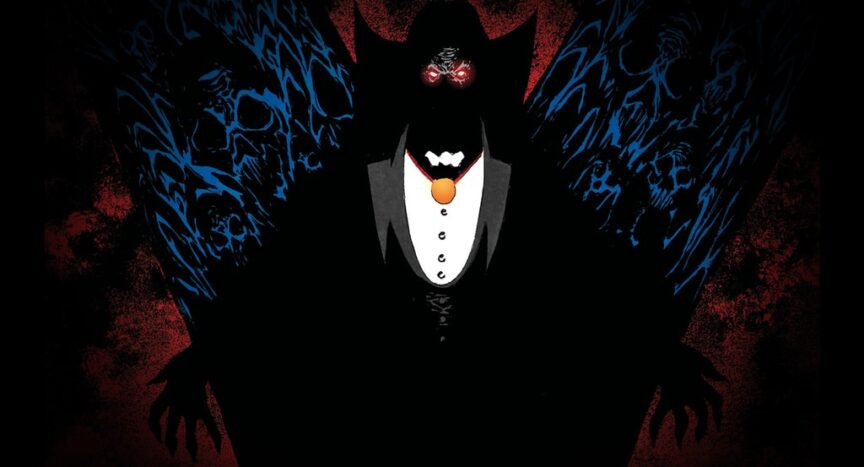Matt Wagner (Grendel) and Kelley Jones (Batman: Red Rain) are returning to their fresh take on Bram Stoker’s 1897 novel Dracula with a new chapter. Dracula Book II – The Count continues their re-telling from the point-of-view of Dracula himself and moves further along in the story in graphic novel form.
The new volume follows Book I – The Impaler and Book II – The Brides from Dark Horse. A Kickstarter has been launched in advance of the new volume’s release.
Wicked Horror posed a few questions for Wagner who’s enjoyed a 40-year career in the comics industry.
WH: In Dracula Book Two: The Brides you take Vlad the Impaler up to the point of looking toward England and taking on the mantle of Count Dracula. What can readers expect of this retelling?
Matt Wagner: As any fan of Bram Stoker’s original novel can tell you, once the action shifts from Transylvania to London, Dracula himself is frustratingly off-stage for most of the remainder of the book. He’s portrayed as more of a sinister presence rather than a physical villain. So, in the same spirit as with both of our previous Dracula volumes, Book I – The Impaler and Book II – The Brides, Kelley and I are bringing readers the stories hidden in the shadows of the original text. Obviously, Dracula is doing something while Stoker’s heroes are trying to track him down and, needless to say, his goals are insidious. One thing I can tell you, there’s nothing romantic about his actions or his interactions with the book’s heroines, Lucy and Mina. This motif of him being obsessed with either one or both of them is a product of various film adaptations. By my reading of the book, he’s not paying much of any attention to Stoker’s heroes for most of his time in London. The book is also full of a lot of narrative coincidences and I try to address those to some degree.

WH: How did you go about exploring the novel to finding details of Dracula’s off-stage scheming and did you discover things you had not noticed before?
Matt Wagner: The original novel is one of the most analyzed and annotated novels in the English language. Since the narrative is epistolary—told in the form of letters, journals and news articles—there’s a definite and distinct time line for the course of events as they unfold; everything’s dated by both month and day. So I had to make sure our story this time around fit seamlessly into this well-recorded and notated tale. I used many sources to make sure things were accurate, including several annotated versions of the novel by authors such as Leonard Wolf and Leslie Klinger. One reference book I used had a calendar of the several months covered in the novel, specifying what happened on each and every day, including the sunset and sunrise times for all of those days and the phases of the moon! There’s some debate amongst Dracula scholars as to what specific year the events are supposed to have taken place. The novel was published in 1897 and the ending of the book claims that it’s been seven years since the narrators faced off with Dracula. That would put the year as 1890…but there’s no indication how much time had transpired since the final journal entries were written and when the book was published. I ended up choosing the year 1888 for reasons that will be evident once you read our tale. It might not surprise anyone to hear that, with this level of scholarship and scrutiny, I feel like this was the most intensive thing I’ve ever written. And, yeah…I discovered so many particular clues as to what Dracula’s motives and movements were during this time. For instance, everyone knows that his secret lair in London is Carfax estate (not an abbey, as it is often mislabeled) but, in fact, Dracula eventually owns four different properties in England, amongst which he distributes his precious cargo of 50 crates containing his native Transylvanian soil. Another important factor I had to consider was the fact that there’s a certain amount of our audience who’ve never even read the original novel! So…I had to make sure this passed the—ahem—taste test for all the hardcore Dracula scholars and fans while also making the story engaging and entertaining for those who were new to this particular part of his history.
WH: What previous visual incarnations of Dracula in comics and film really inspired you?
Matt Wagner: Obviously, both Kelley and I were huge Dracula fans when we began this project so we’re inspired by many, if not all, versions of the character that have appeared since the original novel was published. The Hammer Studios films starring Christopher Lee start off amazing and then kind of lose their juice as the series progresses. They’re also surprisingly linear for a film series of that time, with each new chapter leading fairly straight off the ending of the previous movie. I have a real fondness for the Dan Curtis-directed TV adaptation from the ’70s starring Jack Palance as Dracula and scripted by the legendary Richard Matheson. This version was also the visual inspiration for artist Gene Colon’s design of the character for his long-running Marvel Comics series with writer Marv Wolfman, Tomb of Dracula, and you can really see it in the shape of the face and the eyes and the mouth. The BBC adaptation starring Louis Jordan is also good except for the fact that I find Jordan doesn’t really pull off Dracula’s menacing charisma…and he’s got a distinctly 70s hairdo. I also really like the film version starring Frank Langella, who does have a ton of that Dracula charisma but, once again, sports a modern, blow-dried do. And I have a real love/hate relationship with Coppola’s 90s film version…I think the film-making and sense of cinema is incredible but that the casting is generally awful. And both Kelley and I loved auteur Robert Eggers’s recent remake of Nosferatu…but the character depicted in every screen version of that tale is definitely Count Orlok, not Dracula. In the book, Dracula isn’t nearly as pestilent or cadaverous; he’s strange looking but dignified and courtly and Johnathan Harker comments that his English is well-spoken and bears hardly any trace of a Romanian accent. Like I said, we both are/were big Dracula fans…but we also felt that none of the other various incarnations of the character were exactly perfect, which in turn led us to render our own version of Dracula.
WH: There seems to be a resurgence in the popularity of Dracula over the last few years. The Rosenbach Museum did an extended podcast exploration during Covid, and here at Wicked we recently focused on a young readers graphic novel about the Count. Do you have a thumb on the zeitgeist? What made you say with Dracula Book One: The Impaler: “Now is the time?”
Matt Wagner: Kelley and I have known each other for over thirty years and we’d always made noises about working together some day…but we both wanted that collaboration to be a major project, not just a one-off. I’ve included vampires in the pages of Grendle for years but I’d always wanted to try my hand at the grandaddy of all vampires, Dracula himself. But, let’s face it, the original book has been pretty much adapted to (un)death at this point and I couldn’t quite find a hook for how to treat the character and the narrative in a way that brought something new to the table. But eventually, I hit on this idea of telling all the tales that the novel doesn’t tell, using all the many hints and insinuations found in Stoker’s text. So, the next time Kelley commented to me that, “We really gotta work together some day,” I had a response ready; I said, “Are you really serious about that? Because I think I’ve got an idea that’s absolutely perfect for both of us. But it’s a pretty ambitious project that’ll take us five or six years to complete.” Luckily, the timing was perfect for both of us and so here we are now…deep into what is a true labor of love and we couldn’t be happier with the results. So far as tapping into some greater zeitgeist…I’d have to say we were just lucky on that front but I truly think our version of Dracula is not only scrupulous in its strict adherence to Stoker’s canon but also utterly fresh and unique in its approach.
WH: When you’re finished with this re-telling, are there any other Dracula stories you’d like to tackle? Would you want to resurrect him for tales following the novel’s action? Any famous fictional characters you’d like him to meet?
Matt Wagner: Well, I can tease the answer here with this observation; in the novel, Professor Van Helsing spends some time describing vampires, now to fight them and how to kill them. And then, in the novel’s dramatic finale…the heroes don’t exactly destroy Dracula in any of those proscribed methods. So…you can draw your own conclusions about what we’ve got planned based on that fact.
So far as our title character encountering any other famous literary characters of the same time period, we definitely won’t be going that route. Again, our focus is Dracula himself and the goal is to stay true to Stoker’s original text, so having him encounter, say, Sherlock Holmes or Dr. Jekyll and Mr. Hyde isn’t part of that game plan. And, after all, there’s a bevy of other authors who have already penned those various crossovers narratives in many different media. We’re trying to bring something new…and yet pure… to this portrayal of Dracula.
To contribute to the Kickstarter and earn rewards, visit this link.






